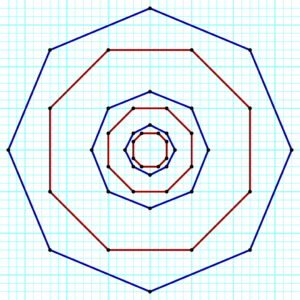Octagon Scalar Antenna
The octagon antenna was developed for combining energetic health balancing and manifestation or Reality hacking. It consists of 4 layers of bifilar octagon coils per plate(PCB), each plate has a phase inversion analogous to its next coil thus forming a solid of a 32 pointed star calculated by Pell’s Number mathematical model.
In mathematics, Pell numbers are an infinite sequence of integers known since ancient times, the denominators of the nearest explicit approximation to the square root of 2. This sequence of approaches begins 1/1, 3/2, 7/5, 17/12, and 41/29, so the sequence of Pell numbers starts with 1, 2, 5, 12, and 29. The numerators of the same sequence of approaches are half of the companion numbers Pell or Pell-Lucas numbers. These numbers form a second infinite sequence beginning with 2, 6, 14, 34, and 82. Together, Pell numbers and companion Pell numbers can be calculated using a repetition ratio similar to that for Fibonacci numbers, and even the two sequences of numbers increase exponentially, in proportion to the forces of the silver ratio 1 + √2. As they are used to approximate the square root of two, Pell numbers can be used to find the square of triangular numbers, to construct the approaches of integers in the right isosceles triangle, and to solve specific combinatorial enumeration problems.
Pell’s numbers seem to apply to the octagonal Bagua mirrors which are made in the shape of an octagon as the octagon according to Chinese philosophy represents creation.
As Knuth (in 1994) describes, the fact that Pell numbers with an approximation of √2 allows them to be used for accurate explicit approaches to a regular octagon with vertex coordinates. All vertices are equally far from the beginning and form almost uniform angles around the beginning. Alternatively, the points (± (P i + P i – 1), 0) , (0, ± (P i + P i – 1)) and (± P i, ± P i) are approximately octagons where the vertices are approximately equal from the beginning and the angles are uniform.
Below are the explicit approximations of the regular octagon, with coordinates derived from Pell numbers and used for the design of the octagon multi-phase antenna.

- explicit approximations of the regular octagon,
- with coordinates derived from Pell numbers.
Esoteric and mystery realm
The bagua mirrors.
Mandalas , Medieval, Church
Studies on the octagon, among others, are sometimes referred to as philosophical, sacred, or contemplative geometry. In this field of inquiry, the octagon was seen symbolically as the intermediary connecting shape between the circle and the square. The three shapes were traditionally drawn vertically, with the circle at the top representing the cosmos, and the square placed at the bottom to represent the earth. The octagon was drawn in between as that shape that connects the two. Occasionally, the octagon was viewed as a symbol for infinity. It was suggested that the octagon is a circle attempting to become a square, and a square attempting to become a circle.
This concept was fully realized in the development of the Hindu vasta-purusha mandala, an ancient type of architecture. Mandala constructions combining the circle and the square usually result in the predominance of four or eight side figures. In China, the octagon represented a complex series of references, but we can say that its meaning was chiefly that of warding off evil entities and being a vehicle for the advent of good health and good fortune. In the number symbolism of Medieval Europe, eight was seen as representing cosmic balance and eternal life. Related to this, the octagon also had deep significance for the Roman Catholic Church. The octagon and the star octagram were religious symbols for rebirth and resurrection. It was used in baptismal fonts in many churches, large and small. J.C. Cooper states that baptismal fonts were octagonal because the octagon symbolizes renewal, rebirth, regeneration, and transition.
As Jay Kappraff has pointed out, “the star octagon, an ecclesiastical emblem, signifies resurrection. In medieval number symbolism, eight signified cosmic equilibrium and immortality”. But were these more religious and metaphysical issues of interest. This symbolism may be tied into the centrally-designed church that utilized octagonal symmetry, but it is difficult to say with complete confidence that the church used the octagon for these reasons. Yet, it is certainly possible. Turning our attention to the mathematical qualities of the octagon, we find that Hermann Weyl, the great twentieth-century Princeton mathematician, made an important observation about the types of centrally-designed churches that Leonardo Da Vinci was designing.